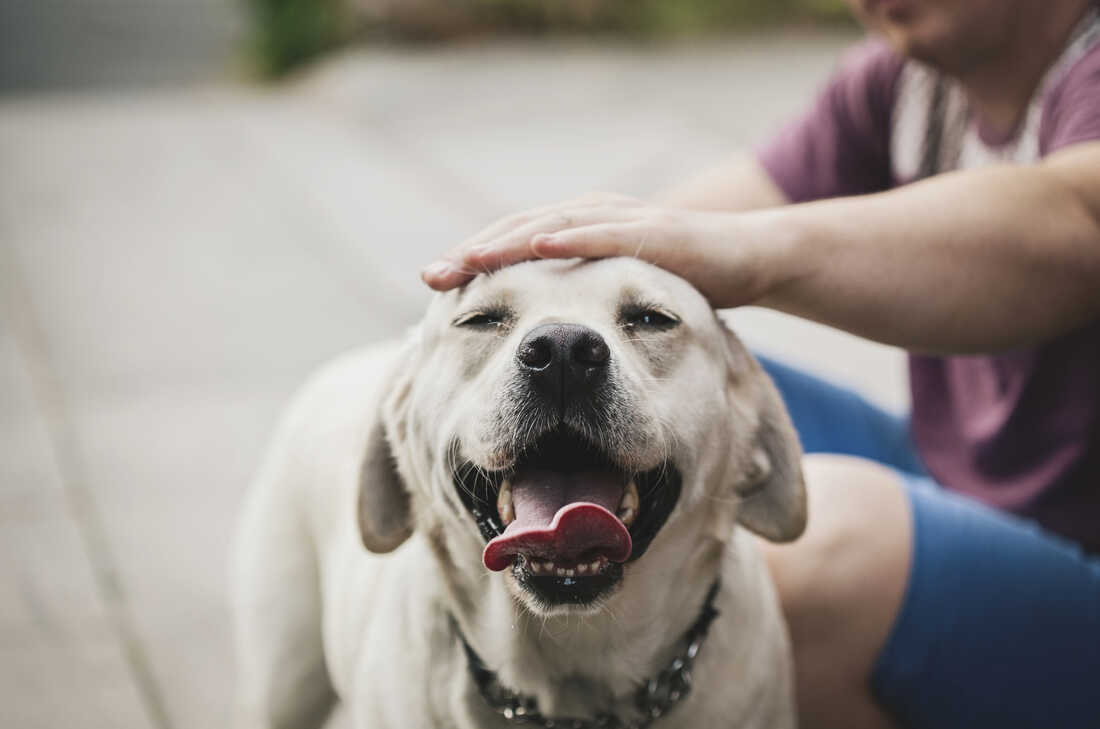
Petting different folks’s (pleasant) canines can increase your well being : Photographs
[ad_1]

When people work together with canines, the feel-good hormone oxytocin will increase — within the individual and the canine.
Sally Anscombe/Getty Photos
cover caption
toggle caption
Sally Anscombe/Getty Photos

When people work together with canines, the feel-good hormone oxytocin will increase — within the individual and the canine.
Sally Anscombe/Getty Photos
What’s four-legged, furry, and sometimes serves up a fast little temper increase?
That is proper, a canine. It seems even quick, pleasant interactions with canines will be good for our well being.
I began pondering the ability of canines throughout one in every of my day by day strolls round my neighborhood. Virtually invariably, I am going to run into a minimum of one individual strolling their canine. If I get the OK to pet the pooch, it is a joyous second of cooing and sloppy kisses.
I at all times stroll away from these canine exchanges feeling only a bit extra relaxed, and comfortable. And that acquired me questioning, might these quick interactions with different folks’s canines truly be good for me?
“Completely. I believe it’s protected to say that animals are helpful to our psychological and bodily well being,” says Nancy Gee, a professor of psychiatry and director of the Heart for Human-Animal Interplay at Virginia Commonwealth College.
Gee says proof is accumulating that ranges of the stress hormone cortisol drop in folks after simply 5 to twenty minutes spent interacting with canines — even when it is not their pet. “Additionally, we see will increase in oxytocin, that feel-good form of bonding hormone,” she says.
And it is not simply people that profit from these temporary exchanges. “What I really like about this analysis is that it is a two-way road,” Gee says. “We see the identical factor within the canines, so the canines’ oxytocin additionally will increase after they work together with a human.”
Now, the remedy canines utilized in analysis are screened for issues like friendliness, good habits and responsiveness to their handler’s cues. And naturally, not everybody’s a canine individual, whether or not due to temperament or allergy symptoms or different elements. “Pets usually are not a panacea,” Gee says. “They don’t seem to be essentially going to be nice for each single individual. However for individuals who actually get it, who actually join with the animals, they actually could make a giant distinction,” Gee says.
Canine possession has additionally been linked to optimistic well being outcomes, together with higher coronary heart well being and elevated bodily exercise. However Gee acknowledges that a few of the proof is blended. She attributes that partly to variations in methodology and the truth that research of pet possession cannot show trigger and impact, since you’ll be able to’t simply randomly assign one individual a canine as a pet and one other a horse.
Analysis on the well being advantages of human interactions with animals – particularly with canines – has exploded lately, due to funding from the Nationwide Institutes of Well being and the Waltham PetCare Science Institute. Although the sphere remains to be younger, Gee says the standard of the proof is enhancing on a regular basis, together with extra randomized managed trials quick interactions. “We’re seeing very nice results,” she says.
For instance, there’s some proof that temporary bouts of pet love might assist us suppose higher. Gee collaborated on a randomized managed trial of 8 and 9-year-old faculty youngsters within the U.Ok. She and her colleagues discovered that children who had twice-weekly, quick exchanges with canines within the classroom had much less stress and improved govt functioning – the cognitive processes that permit us to do issues like plan, keep on job and block out distractions. And she or he says these advantages lingered.
“We truly noticed [those effects] one month later. And there is some proof that [they] might exist six months later,” Gee says.
So what’s it about hanging out with canines that helps us sit back and focus? Megan Mueller, an affiliate professor on the Cummings College of Veterinary Medication at Tufts College, says canines immediate us to expertise the world extra like they do.
“Animals, and canines specifically, dwell within the second. They’re experiencing their surroundings with surprise and awe on a regular basis, and so they’re not citing what occurred to them earlier within the day or what they’re occupied with sooner or later. They’re there proper now,” says Mueller.
Mueller, whose analysis focuses on the psychology of human-animal relationships, says watching canines sniff the grass or discover the world round them cues us to pay extra consideration, too. “They kind of pull you out of your cellphone and into no matter surroundings that you simply’re in.”
She says there’s some proof that the act of really touching a canine may be an essential a part of their calming impact. For example, one examine achieved in Canada discovered that faculty college students reported much less stress and lowered emotions of homesickness after temporary interactions with canines, and that impact was a lot greater in those that truly acquired to pet the animals. She’s at the moment working a examine that is discovering related outcomes.
“Among the preliminary analysis has proven that bodily contact may impression our nervous system in a approach that is helpful,” Mueller says.
However it’s not simply how we cue into canines that makes the connection particular. Gee of Virginia Commonwealth College says over hundreds of years of domestication, canines have developed a wondrous potential to learn us people.
“They actually can join with one other human being. They usually do it in a really unassuming approach,” Gee says.
They usually do it with out the power to make use of phrases. As my dog-loving 9-year-old just lately instructed me, canines simply have a approach of chatting with our hearts.
[ad_2]


